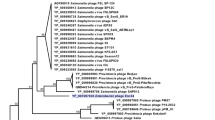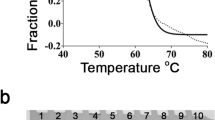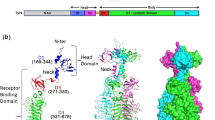Abstract
Phages infecting the polysialic acid (polySia)-encapsulated human pathogen Escherichia coli K1 are equipped with capsule-degrading tailspikes known as endosialidases, which are the only identified enzymes that specifically degrade polySia. As polySia also promotes cellular plasticity and tumor metastasis in vertebrates, endosialidases are widely applied in polySia-related neurosciences and cancer research. Here we report the crystal structures of endosialidase NF and its complex with oligomeric sialic acid. The structure NF, which reveals three distinct domains, indicates that the unique polySia specificity evolved from a combination of structural elements characteristic of exosialidases and bacteriophage tailspike proteins. The endosialidase assembles into a catalytic trimer stabilized by a triple β-helix. Its active site differs markedly from that of exosialidases, indicating an endosialidase-specific substrate-binding mode and catalytic mechanism. Residues essential for endosialidase activity were identified by structure-based mutational analysis.
This is a preview of subscription content, access via your institution
Access options
Subscribe to this journal
Receive 12 print issues and online access
$189.00 per year
only $15.75 per issue
Buy this article
- Purchase on Springer Link
- Instant access to full article PDF
Prices may be subject to local taxes which are calculated during checkout





Similar content being viewed by others
References
Kleene, R. & Schachner, M. Glycans and neural cell interactions. Nat. Rev. Neurosci. 5, 195–208 (2004).
Jodar, L., Feavers, I.M., Salisbury, D. & Granoff, D.M. Development of vaccines against meningococcal disease. Lancet 359, 1499–1508 (2002).
Merril, C.R., Scholl, D. & Adhya, S.L. The prospect for bacteriophage therapy in Western medicine. Nat. Rev. Drug Discov. 2, 489–497 (2003).
Gross, R.J., Cheasty, T. & Rowe, B. Isolation of bacteriophages specific for the K1 polysaccharide antigen of Escherichia coli. J. Clin. Microbiol. 6, 548–550 (1977).
Smith, H.W. & Huggins, M.B. Successful treatment of experimental Escherichia coli infections in mice using phage: its general superiority over antibiotics. J. Gen. Microbiol. 128, 307–318 (1982).
Vimr, E.R., McCoy, R.D., Vollger, H.F., Wilkison, N.C. & Troy, F.A. Use of prokaryotic-derived probes to identify poly(sialic acid) in neonatal neuronal membranes. Proc. Natl. Acad. Sci. USA 81, 1971–1975 (1984).
Miyake, K. et al. Screening of bacteriophages producing endo-N-acetylneuraminidase. J. Ferm. Bioeng. 84, 90–93 (1997).
Pelkonen, S., Aalto, J. & Finne, J. Differential activities of bacteriophage depoly-merase on bacterial polysaccharide: binding is essential but degradation is inhibitory in phage infection of K1-defective Escherichia coli. J. Bacteriol. 174, 7757–7761 (1992).
Petter, J.G. & Vimr, E.R. Complete nucleotide sequence of the bacteriophage K1F tail gene encoding endo-N-acylneuraminidase (endo-N) and comparison to an endo-N homolog in bacteriophage PK1E. J. Bacteriol. 175, 4354–4363 (1993).
Mühlenhoff, M., Stummeyer, K., Grove, M., Sauerborn, M. & Gerardy-Schahn, R. Proteolytic processing and oligomerization of bacteriophage-derived endosialidases. J. Biol. Chem. 278, 12634–12644 (2003).
Gerardy-Schahn, R. et al. Molecular cloning and functional expression of bacteriophage PK1E- encoded endoneuraminidase endo NE. Mol. Microbiol. 16, 441–450 (1995).
Long, G.S., Bryant, J.M., Taylor, P.W. & Luzio, J.P. Complete nucleotide sequence of the gene encoding bacteriophage E endosialidase: implications for K1E endosialidase structure and function. Biochem. J. 309, 543–550 (1995).
Scholl, D., Rogers, S., Adhya, S. & Merril, C.R. Bacteriophage K1-5 encodes two different tail fiber proteins, allowing it to infect and replicate on both K1 and K5 strains of Escherichia coli. J. Virol. 75, 2509–2515 (2001).
Henrissat, B. & Bairoch, A. Updating the sequence-based classification of glycosyl hydrolases. Biochem. J. 316, 695–696 (1996).
Hallenbeck, P.C., Vimr, E.R., Yu, F., Bassler, B. & Troy, F.A. Purification and properties of a bacteriophage-induced endo-N- acetylneuraminidase specific for poly-α-2,8-sialosyl carbohydrate units. J. Biol. Chem. 262, 3553–3561 (1987).
Pelkonen, S., Pelkonen, J. & Finne, J. Common cleavage pattern of polysialic acid by bacteriophage endosialidases of different properties and origins. J. Virol. 63, 4409–4416 (1989).
Tulip, W.R. et al. Refined atomic structures of N9 subtype influenza virus neuraminidase and escape mutants. J. Mol. Biol. 221, 487–497 (1991).
Varghese, J.N. & Colman, P.M. Three-dimensional structure of the neuraminidase of influenza virus A/Tokyo/3/67 at 2.2 Å resolution. J. Mol. Biol. 221, 473–486 (1991).
Burmeister, W.P., Ruigrok, R.W. & Cusack, S. The 2.2 Å resolution crystal structure of influenza B neuraminidase and its complex with sialic acid. EMBO J. 11, 49–56 (1992).
Crennell, S.J., Garman, E.F., Laver, W.G., Vimr, E.R. & Taylor, G.L. Crystal structure of a bacterial sialidase (from Salmonella typhimurium LT2) shows the same fold as an influenza virus neuraminidase. Proc. Natl. Acad. Sci. USA 90, 9852–9856 (1993).
Crennell, S., Garman, E., Laver, G., Vimr, E. & Taylor, G. Crystal structure of Vibrio cholerae neuraminidase reveals dual lectin-like domains in addition to the catalytic domain. Structure 2, 535–544 (1994).
Crennell, S., Takimoto, T., Portner, A. & Taylor, G. Crystal structure of the multifunctional paramyxovirus hemagglutinin-neuraminidase. Nat. Struct. Biol. 7, 1068–1074 (2000).
Gaskell, A., Crennell, S. & Taylor, G. The three domains of a bacterial sialidase: a β-propeller, an immunoglobulin module and a galactose-binding jelly-roll. Structure 3, 1197–1205 (1995).
Luo, Y., Li, S.C., Chou, M.Y., Li, Y.T. & Luo, M. The crystal structure of an intramolecular trans-sialidase with a NeuAc α2→3Gal specificity. Structure 6, 521–530 (1998).
Buschiazzo, A. et al. Structural basis of sialyltransferase activity in trypanosomal sialidases. EMBO J. 19, 16–24 (2000).
Chong, A.K.J., Pegg, M.S., Taylor, N.R. & von Itzstein, M. Evidence for a sialosyl cation transition-state complex in the reaction of sialidase from influenza-virus. Eur. J. Biochem. 207, 335–343 (1992).
Watts, A.G. et al. Trypanosoma cruzi trans-sialidase operates through a covalent sialyl-enzyme intermediate: tyrosine is the catalytic nucleophile. J. Am. Chem. Soc. 125, 7532–7533 (2003).
Watson, J.N., Dookhun, V., Borgford, T.J. & Bennet, A.J. Mutagenesis of the conserved active-site tyrosine changes a retaining sialidase into an inverting sialidase. Biochemistry 42, 12682–12690 (2003).
Amaya, M.F. et al. Structural insights into the catalytic mechanism of Trypanosoma cruzi trans-sialidase. Structure 12, 775–784 (2004).
Daniel, L. et al. A nude mice model of human rhabdomyosarcoma lung metastases for evaluating the role of polysialic acids in the metastatic process. Oncogene 20, 997–1004 (2001).
Mushtaq, N., Redpath, M.B., Luzio, J.P. & Taylor, P.W. Prevention and cure of systemic Escherichia coli K1 infection by modification of the bacterial phenotype. Antimicrob. Agents Chemother. 48, 1503–1508 (2004).
Taylor, G. Sialidases: Structures, biological significance and therapeutic potential. Curr. Opin. Struct. Biol. 6, 830–837 (1996).
Nissen, P. et al. Crystal structure of the ternary complex of Phe-tRNAPhe, EF-Tu, and a GTP analog. Science 270, 1464–1472 (1995).
Steinbacher, S. et al. Crystal structure of P22 tailspike protein: interdigitated subunits in a thermostable trimer. Science 265, 383–386 (1994).
van Raaij, M.J., Schoehn, G., Burda, M.R. & Miller, S. Crystal structure of a heat and protease-stable part of the bacteriophage T4 short tail fiber. J. Mol. Biol. 314, 1137–1146 (2001).
Kanamaru, S. et al. Structure of the cell-puncturing device of bacteriophage T4. Nature 415, 553–557 (2002).
Chappell, J.D., Gunn, V.L., Wetzel, J.D., Baer, G.S. & Dermody, T.S. Mutations in type 3 reovirus that determine binding to sialic acid are contained in the fibrous tail domain of viral attachment protein sigma 1. J. Virol. 71, 1834–1841 (1997).
Buschiazzo, A., Amaya, M.F., Cremona, M.L., Frasch, A.C. & Alzari, P.M. The crystal structure and mode of action of trans-sialidase, a key enzyme in Trypanosoma cruzi pathogenesis. Mol. Cell 10, 757–768 (2002).
Kitazume, S., Kitajima, K., Inoue, S. & Inoue, Y. Detection, isolation, and characterization of oligo/poly(sialic acid) and oligo/poly(deaminoneuraminic acid) units in glycoconjugates. Anal. Biochem. 202, 25–34 (1992).
Manzi, A.E., Higa, H.H., Diaz, S. & Varki, A. Intramolecular self-cleavage of polysialic acid. J. Biol. Chem. 269, 23617–23624 (1994).
Whitfield, C., Vimr, E.R., Costerton, J.W. & Troy, F.A. Protein synthesis is required for in vivo activation of polysialic acid capsule synthesis in Escherichia coli K1. J. Bacteriol. 159, 321–328 (1984).
Collaborative Computational Project, Number 4. The CCP4 suite: programs for protein crystallography. Acta Crystallogr. D 50, 760–763 (1994).
Sheldrick, G.M., Hauptman, H.A., Weeks, C.M., Miller, R. & Usón, I. In International Tables for Crystallography Vol. F (eds. Rossmann, M.G. & Arnold, E.) 333–351 (Kluwer Academic, Dordrecht, The Netherlands, 2001).
Cowtan, K.D. & Zhang, K.Y. Density modification for macromolecular phase improvement. Prog. Biophys. Mol. Biol. 72, 245–270 (1999).
Jones, T.A., Zou, J.Y., Cowan, S.W. & Kjeldgaard, M. Improved methods for building protein models in electron-density maps and the location of errors in these models. Acta Crystallogr. A 47, 110–119 (1991).
McRee, D.E. XtalView/Xfit - a versatile program for manipulating atomic coordinates and electron density. J. Struct. Biol. 125, 156–165 (1999).
Perrakis, A., Morris, R. & Lamzin, V.S. Automated protein model building combined with iterative structure refinement. Nat. Struct. Biol. 6, 458–463 (1999).
Murshudov, G.N., Vagin, A.A., Lebedev, A., Wilson, K.S. & Dodson, E.J. Efficient anisotropic refinement of macromolecular structures using FFT. Acta Crystallogr. D 55, 247–255 (1999).
Schüttelkopf, A.W. & Van Aalten, D.M. PRODRG: a tool for high-throughput crystallography of protein-ligand complexes. Acta Crystallogr. D 60, 1355–1363 (2004).
Holm, L. & Sander, C. Touring protein fold space with Dali/FSSP. Nucleic Acids Res. 26, 316–319 (1998).
Weisgerber, C. et al. Embryonic neural cell adhesion molecule in cerebrospinal fluid of younger children: age-dependent decrease during the first year. J. Neurochem. 55, 2063–2071 (1990).
Frosch, M., Gorgen, I., Boulnois, G.J., Timmis, K.N. & Bitter-Suermann, D. NZB mouse system for production of monoclonal antibodies to weak bacterial antigens: isolation of an IgG antibody to the polysaccharide capsules of Escherichia coli K1 and group B meningococci. Proc. Natl. Acad. Sci. USA 82, 1194–1198 (1985).
Laemmli, U.K. Cleavage of structural proteins during the assembly of the head of bacteriophage T4. Nature 227, 680–685 (1970).
Acknowledgements
We thank the staff of European Molecular Biology Laboratory beamline at DESY, Hamburg, and the staff of the PSF beamline at BESSY, Berlin, for guidance during data collection. We are grateful to our colleague O. Einsle for help during the crystal structure analysis. This work was supported by the Deutsche Forschungsgemeinschaft and the Fonds der Chemischen Industrie.
Author information
Authors and Affiliations
Corresponding author
Ethics declarations
Competing interests
The authors declare no competing financial interests.
Supplementary information
Supplementary Fig. 1
Binding of inactive endoNF mutants to polySia. (PDF 159 kb)
Rights and permissions
About this article
Cite this article
Stummeyer, K., Dickmanns, A., Mühlenhoff, M. et al. Crystal structure of the polysialic acid–degrading endosialidase of bacteriophage K1F. Nat Struct Mol Biol 12, 90–96 (2005). https://doi.org/10.1038/nsmb874
Received:
Accepted:
Published:
Issue Date:
DOI: https://doi.org/10.1038/nsmb874
This article is cited by
-
Salmonid polysialyltransferases to generate a variety of sialic acid polymers
Scientific Reports (2023)
-
Neuroimmunomodulatory properties of polysialic acid
Glycoconjugate Journal (2023)
-
Genomic analysis and biological characterization of a novel Schitoviridae phage infecting Vibrio alginolyticus
Applied Microbiology and Biotechnology (2023)
-
Structure of Escherichia coli O157:H7 bacteriophage CBA120 tailspike protein 4 baseplate anchor and tailspike assembly domains (TSP4-N)
Scientific Reports (2022)
-
Polysialic acid and Siglec-E orchestrate negative feedback regulation of microglia activation
Cellular and Molecular Life Sciences (2021)



